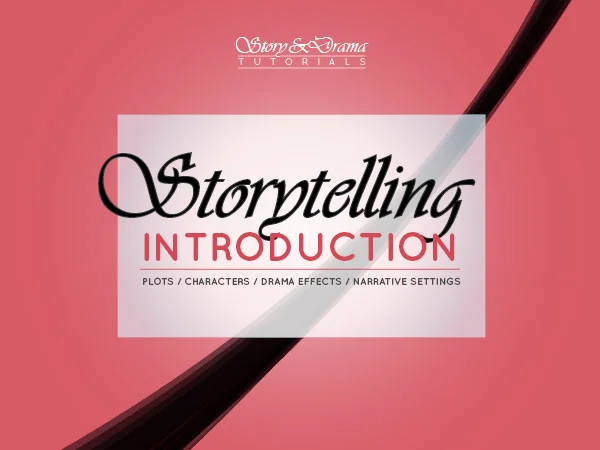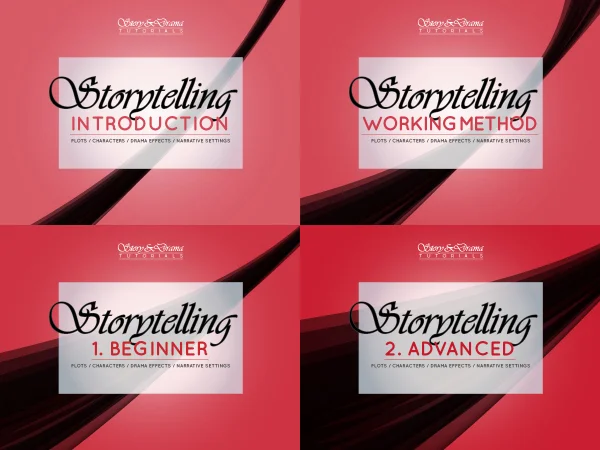 |
|
PDF, 20 pages, free
|
| Download the free PDF Storytelling Introduction |
How to write a story
This free scenario class presents the main concepts of storytelling: plots, characters and set of characters, story architecture, drama effects… usable in any media, genre or style, for scriptwriting, screenwriting, playwriting, songwriting…
It is abstracted from Storytelling 1 – Essentials and Storytelling 2 – Advanced and introduces them.
What is storytelling?
The tools of storytelling
Storytelling is the theory, analysis and art of stories and of anything narrative in general.
As a creative and analytic tool, storytelling uses:
- concepts (like “plot“, “character“, “actantial role“, “system of values“, “goal“, “motivation“, “genre“, “emotion“, etc…)
- text descriptions (summaries of plots, portrait of characters, descriptions of actions, lists of themes…)
- schemes (like the standard plot scheme or the set of characters presented here),
- methods (developing a character into a set of characters, filling the gaps of a plot, building an architecture of plots, setting up the themes of a complex story…)
- and medias (to write, we use different paper formats, cards, various softwares, and sometimes visual medias (storyboard)).
Who uses storytelling and how to make progress?
Storytelling as a theory and practice is the skill of tellers, whatever art and media they might have chosen to tell heir stories, whether it be through movies, books TV shows, music,
games, advertisements, speeches or even by political actions…
Every storyteller started from our common skill to tell stories. We can all make progress and learn telling better. Nothing warrants we are geniuses, but a bit of work warrants that
our next stories will be told a more mastered way.
One progresses by 3 ways:
- theory,
- analysis
- and practice.
To help you learn the main concepts and tools of storytelling, we developed the Story&Drama Tutorials.
- As a complement, we offer analyses of masterworks in various arts.
- If you want help while conceiving or writing a story, I can provide personalized services.
Why do we tell?
Telling stories is in human nature. We can all do it.
Why can we do it?
Probably because stories are a way to store information about what the world is and how it works, about what to do and what to avoid doing. It is a school of life, in which we record
experiences that we only live in imagination.
As such, stories carry our vision of the world and the characters carry our values and stage conflicts between those visions of the world and values: who will win, good or evil, the Hero or his Antagonist?
Telling has consequences
A story is not neutral and its audience is not supposed to stay indifferent towards it. On the contrary, stories are used to have an influence over the world, to take action.
A story also delivers an engaged message and has an impact over its audience.
This impact can be for example:
- An action (like, changing one’s consumer choices after having seen a campaign against a given product)
- A belief (like, homosexuality is acceptable and homophobia is not)
- An emotion (like, the various feelings we develop during a love story).
Whatever we tell, we have a purpose, an intention, a goal:
- Imagine that you are a married woman and suddenly your husband tells you of all of the romantic escapades he has been having outside of your marriage this year. Will you not
react one way or another, and take action from what you feel after having heard those charming love stories? - Imagine you are a journalist and you discover that a past well known criminal has now become the Prime Minister of your country. You have a moral dilemma, if your story is true;
it is possible that the Prime Minister will dismiss it, however if it is false you will most certainly lose your job. Either way, this story has clear, concrete consequences. - Imagine you are in love and you tell jokes to the person you are in love with. Here again, your jokes are supposed to stimulate a reaction of laughter which means that this person
likes you. You tell jokes to get loved, they are not told “just for fun”: the proof is that you do not tell them when you are not attracted.
Summary
What is storytelling?
- The tools of storytelling
- Who uses storytelling and how to make progress
- Why do we tell?
- Telling has consequences
Plots
- Definition
- How to write a standard plot
Characters
- A plot tells what happens to a Hero
- A plot tells the conflict between a Hero and his/her Antagonist
- Hero and Antagonist have Helpers, Mentors and Skeptics
Mixing plots
- Simple stories
- Complex stories
- Types of multi-plot structures
Drama effects
- Use tools and techniques
- Distribute information to the characters and to the audience
- Make special effects
- Manage drama parameters
Special offer – 4 scenario tutorials for only $30
Story&Drama offers you 4 scenario tutorials for $30
Get them all at once and download them immediately.
 |
|
|
4 PDF
|
|